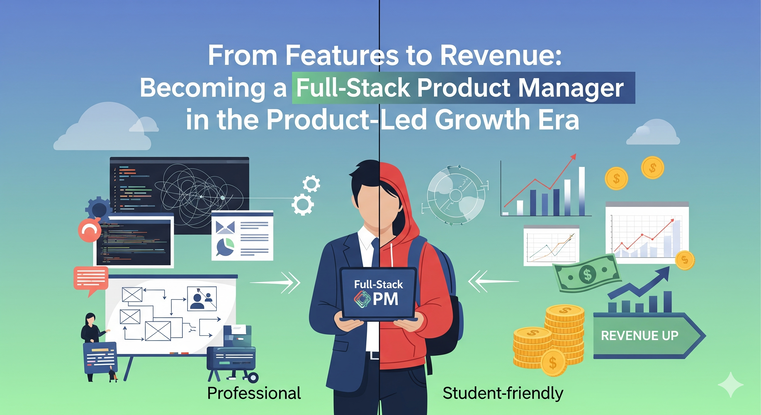
From Features to Revenue: Becoming a Full-Stack Product Manager in the Product-Led Growth Era
Introduction
The role of a Product Manager (PM) has evolved significantly over the past decade. Gone are the days when PMs were solely responsible for defining features and coordinating with engineering teams. In today’s Product-Led Growth (PLG) era, product managers must think beyond features — they need to align product strategy with measurable business outcomes such as revenue, customer acquisition, and retention.
This shift has given rise to the concept of the Full-Stack Product Manager — a professional who blends product strategy, user experience, analytics, growth marketing, and business acumen to drive sustainable growth.
In this blog, we’ll dive deep into what it means to be a full-stack PM, the skills you need, strategies to succeed in the PLG era, and how you can future-proof your career with the right training.
What is a Full-Stack Product Manager?A Full-Stack Product Manager is not just a product owner or feature manager — they’re a business driver who connects user needs with company objectives. Unlike traditional PMs, full-stack PMs:
-
Align features with revenue growth strategies.
-
Understand user psychology and product adoption cycles.
-
Leverage data analytics and AI-driven insights for decision-making.
-
Collaborate with marketing, sales, design, and engineering teams seamlessly.
-
Build products that sell themselves through user experience, not just sales pitches.
In short, they balance strategic vision with execution, ensuring that every feature contributes to the company’s bottom line.
👉 Related read: Types of AI Models: What They Are and How They Work
Why the PLG Era Demands Full-Stack PMsProduct-Led Growth (PLG) means that the product itself is the main driver of user acquisition, conversion, and retention. Successful companies like Slack, Notion, Figma, and Zoom didn’t rely on aggressive sales tactics — instead, they created products so intuitive and valuable that users naturally spread them.
For PMs in the PLG era:
-
Metrics Features → It’s not enough to ship features; PMs must show impact on activation, retention, and revenue.
-
Data-driven decisions → Product analytics, A/B testing, and funnel optimization are critical.
-
Cross-functional leadership → You must influence teams beyond product — marketing, customer success, and even finance.
-
AI integration → Modern PLG companies are embedding AI into products for personalization and efficiency, making AI literacy a must-have skill for PMs.
👉 Also read: What is Google Analytics and How Does It Work?
Key Skills of a Full-Stack Product ManagerTo thrive as a full-stack PM, you need a holistic skill set that covers both hard and soft skills:
1. Strategic Thinking-
Defining product roadmaps that align with business KPIs.
-
Translating customer insights into growth opportunities.
-
Familiarity with APIs, cloud services, and modern product stacks (MERN, serverless, AI integrations).
-
Understanding engineering trade-offs without micromanaging developers.
-
Expertise in analytics tools like Google Analytics, Mixpanel, Amplitude.
-
Ability to define North Star Metrics and measure ROI of product decisions.
-
Knowledge of onboarding optimization, freemium strategies, and upsell funnels.
-
Running growth experiments to test product-market fit.
-
Cross-functional collaboration across engineering, design, sales, and marketing.
-
Storytelling skills to align stakeholders around vision.
👉 Explore: Affiliate Network vs Affiliate Program: Which to Choose?
From Features to Revenue: The Shift in PM ResponsibilityTraditionally, PMs would focus on:
-
Gathering requirements
-
Prioritizing features
-
Managing product delivery
But in today’s PLG environment, a full-stack PM is responsible for:
-
Revenue Impact → Every feature must connect to business value.
-
User Retention → Building experiences that keep customers coming back.
-
Expansion → Driving upsells, cross-sells, and product stickiness.
-
Scalable Growth → Designing products that scale globally with minimal sales dependency.
In other words, the modern PM is as much a growth leader as a product builder.
How to Become a Full-Stack Product Manager 1. Build Technical LiteracyYou don’t need to code full-time, but learning the basics of APIs, cloud infrastructure, and AI integration will make you a stronger PM.
2. Master Product AnalyticsLearn to use Google Analytics, Mixpanel, Amplitude, and AI-powered tools. Understand cohorts, funnels, and retention analysis.
3. Learn Growth Marketing PrinciplesUnderstand customer acquisition, retention loops, and virality mechanics. PMs who know growth metrics can design better features.
4. Develop Business AcumenLearn how product decisions impact revenue, unit economics, and CAC vs LTV.
5. Get CertifiedEnroll in structured Product Management Courses that focus on PLG and full-stack skills.
👉 Check out our Full-Stack Product Management Course — designed for aspiring PMs looking to master product-led strategies and become industry-ready in 2025.
Looking ahead, PMs will need to adapt to AI-driven product development, hyper-personalization, and global digital-first customer journeys. Companies will expect PMs to own end-to-end product performance rather than just delivery.
The demand for full-stack PMs is skyrocketing, with companies actively hiring professionals who can bridge product vision with revenue growth.
ConclusionIn the Product-Led Growth era, becoming a full-stack product manager is no longer optional — it’s the key to staying relevant in a competitive job market. By blending strategy, technology, data, and growth marketing, you can transform from a feature manager into a revenue driver.
If you’re ready to take your product career to the next level, invest in developing a full-stack mindset and consider structured training to fast-track your journey.
👉 Start today with our Full-Stack Product Management Course and future-proof your career.






